Abstract
Air pollution has been an increasing concern within the Kingdom of Saudi Arabia and other Middle Eastern countries. In this work the authors present an analysis of daily ozone (O3), nitrogen oxide (NOx), and particulate matter (<10 μm aerodynamic diameter; PM10) concentrations for two years (2010 and 2011) at sites in and around the coastal city of Jeddah, as well as a remote background site for comparison. Monthly and weekly variations, along with their implications and consequences, were also examined. O3 within Jeddah was remarkably low, and exhibited the so-called weekend effect—elevated O3 levels on the weekends, despite reduced emissions of O3 precursors on those days. Weekend O3 increases averaged between 12% and 14% in the city, suggesting that NOx/volatile organic compound (VOC) ratios within cities such as Jeddah may be exceptionally high. Sites upwind or far removed from Jeddah did not display this weekend effect. Based on these results, emission control strategies in and around Jeddah must carefully address NOx/VOC ratios so as to reduce O3 at downwind locations without increasing it within urban locations themselves. PM10 concentrations within Jeddah were elevated compared with North American cites of similar climatology, though comparable to other large cities within the Middle East.
Implications:
Daily concentrations of O3, PM10, and NOx in and around the city of Jeddah, Saudi Arabia, are analyzed and compared with those of other reference cities. Extremely low O3 levels, along with a significant urban weekend effect (higher weekend O3, despite reduced NOx concentrations), is apparent, along with high levels of PM10 within the city. Urban O3 in Jeddah was found to be lower than that of other comparable cities, but the strong weekend effect suggests that care must be taken to reduce downwind O3 levels without increasing them within the city itself. Further research into the emissions and chemistry contributing to the reduced O3 levels within the city is warranted.
Introduction
Tropospheric ozone (O3) and particulate matter (<10 μm aerodynamic diameter; PM10) are known pollutants with established correlations to increases in mortality and morbidity in human populations, even at low concentrations (Dockery and Pope, Citation1994; Lippmann, Citation1989). Numerous studies examining both short- and long-term increases in O3 and PM10 have shown elevated rates of deaths and hospitalizations associated with respiratory and cardiovascular diseases for each of these pollutants, with recent work confirming the connection (Bell, Citation2004; Anenberg et al., Citation2009; Samoli et al., Citation2005). Because of these and similar studies, O3 and PM are both among the most common pollutants regulated with established standards, both national and international. The World Health Organization (WHO), for example, recommends 8-hr daily maximums of O3 no greater than 100 μg m−3, and annual averages of PM10 lower than 20 μg m−3 (Krzyzanowski and Cohen, Citation2008). Although regulated thresholds vary by country, and are often less stringent than those recommended by the WHO, average and daily levels of these pollutants are clearly of concern, especially in urban areas characterized by high emissions and high population densities.
Although the Kingdom of Saudi Arabia has been identified as exhibiting signs of increased air quality degradation in recent decades, thus far there has been limited analysis of urban and rural pollutant concentrations and trends. Previous studies have shown high concentrations of carbon monoxide (CO) and other pollutants in Jeddah (Nasralla, Citation1983), elevated PM10 concentrations in the Saudi capital of Riyadh (Rowe et al., Citation1985), increasing incidence of asthma (Al Frayh et al., Citation2001), and elevated CO concentrations in and around the major urban centers of Saudi Arabia (Tangborn et al., Citation2009), as well as positive trends in O3 and PM10 in the city of Meccah (Munir et al., Citation2013), but a great deal of uncertainty remains in regards to the characterization of Saudi air quality. One obstacle to further analysis has been an absence of high-resolution emission inventories, limiting the efficacy of regional chemical transport models. In this work, pollutant concentration data collected within the major Saudi city of Jeddah are analyzed and compared with data collected both just upwind and at a remote rural site. Through this initial attempt at documenting and characterizing typical concentrations and behaviors of pollutants in this highly traveled area, we hope to establish a foundation upon which future examinations of diurnal cycles, fine particulate matter (<2.5 μm aerodynamic diameter; PM2.5) concentration and composition, and emission inventories can be based. Ultimately, the results of this work and those of any follow-up studies can be used to make policy recommendations mitigating pollution-related health risks for citizens and pilgrims in and around the city of Jeddah.
Methodology
Jeddah overview
The second-largest city in Saudi Arabia and the largest in the province of Mecca, the city of Jeddah serves as a major hub for travel and commerce in the region, and as such has been a focal point for air quality studies around the Persian Gulf area. Because Jeddah is a primary transportation conduit for Muslim pilgrims visiting the city of Mecca, local air quality is of particular concern. Recent studies have identified Jeddah as a strong source of the known pollutant CO (Tangborn et al., Citation2009) as well as nitrogen oxides (NOx), a primary contributor to tropospheric ozone (O3) (Lelieveld et al., Citation2009), and satellite measurements of tropospheric nitrogen dioxide (NO2) columns appear to confirm the presence of emission hotspots within Saudi Arabia, especially around the cities of Jeddah and Riyadh (Boersma et al., Citation2004, Citation2007). The footprint of NOx emissions from these two cities, as well as smaller areas along the Red Sea and high-emission areas all around the Persian Gulf, extends throughout much of the northern half of the country, although areas averaging less than 1015 molecules cm−2 still dominate the region overall (van der A et al., Citation2008). Characterizing air quality behavior at both high-NOx urban regions and low-NOx remote areas will be important for determining accurate projections and effective policy in the years to come.
Station locations and equipment
Measurements of meteorology and atmospheric composition were taken daily throughout 2010 and 2011 at four stations in and just outside the city of Jeddah: a central station in the Bani Malik District, another in the industrial area on the south side of the city, a third to the north outside the Ministry of Education Stadium, and a final coastal station upwind and north of the city in the Al Ammouaj District (). For comparison with these Jeddah sites, a fifth station was also set up at the northern edge of Saudi Arabia in Haql, approximately 930 km up the coast of the Red Sea. Nitric oxide (NO), NO2, and NOx were measured using Environnement S.A. (France) AC32M chemiluminescent detectors (lower detectable limit of 1 ppb). O3 was detected via ultraviolet (UV) absorption using O342M ozone analyzers (lower detectable limit of 0.4 ppb), whereas Environnement S.A. MP101M beta gauges were used to measure particulate matter (lower detectable limit of 0.5 μg PM10 for daily averages). Trace gas instruments were calibrated weekly, and the MP101 particulate matter beta gauge was calibrated monthly. All meteorological measurements were taken using Vaisala WXT510 weather transmitters (temperature measured at 0.1 °C resolution ±0.3 °C; relative humidity [RH] measured to within 3% for RH <90% and to within 5% for RH >90%; wind speed measured at 0.1 m/sec resolution ±3% at 10 m/sec; wind direction measured at 1° resolution ±3°).
Figure 1. Sampling station locations, with notable local emission sources indicated by letter-coded points (Khodeir et al., Citation2012). Sources include King Abdulaziz International Airport (A), a water treatment plant (B), a desalination plant (C), Jeddah Seaport (D), an oil refinery (E), and a power plant (F).
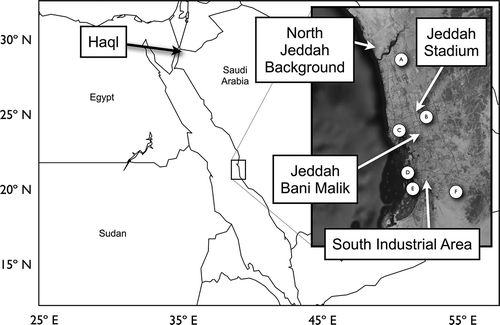
Results and Discussion
Annual averages
Overall temperatures within central Jeddah were noticeably higher than those at the remote North Kingdom Haql site, and slightly higher than those at the North Jeddah Background station (). Relative humidities were typically between 40% and 60% at all three urban stations, with higher averages at the northern Jeddah background station (60% ± 10%) and lower averages at the North Kingdom Haql station (40% ± 9%). NOx emissions, and therefore average concentrations, were clearly elevated within Jeddah. Although the city station averages were all around 40 μg m−3, the two more remote sites rarely exceeded 20 μg m−3. High levels of PM10 were also more frequent in the city relative to the more remote locations. Annual O3 levels were inversely correlated to those of NOx, with the more remote sites showing higher values, on average. Relative to comparable cities, average concentrations of O3 within Jeddah are remarkably low, whereas PM10 concentrations (though high compared with U.S. cities) are similar to those found in other large Middle Eastern cities ().
Figure 2. Total distributions of average daily temperature, NOx, PM10, and O3 for each site over 2010 and 2011. Horizontal lines on each box indicate quartile values (25th, 50th, and 75th percentiles). Whiskers show 5th and 95th percentiles. Station codes represent South Industrial Area (SIA), Jeddah Bani Malik (JBM), Jeddah Stadium (JST), North Jeddah Background (NJB), and North Kingdom Haql (NKH).
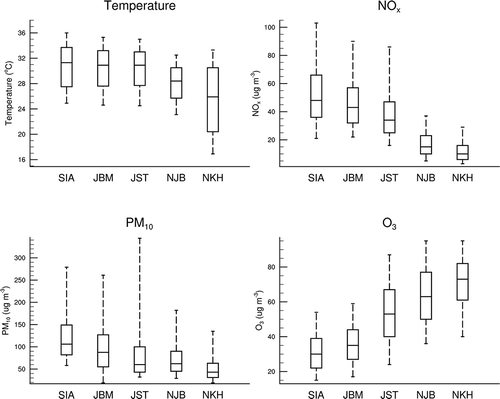
Figure 3. Average daily levels of O3 and concentrations of PM10 both at and upwind of Jeddah, along with values at other selected cities for comparison. Jeddah values represent averaged JBM, JST, and SIA sites, whereas background values are from the NJB site. Las Vegas and Phoenix values represent recent annual averages measured at U.S. Environmental Protection Agency Air Quality System (AQS) stations within those cities (U.S. Environmental Protection Agency, Citation2013). Abu Dhabi and Cairo values are taken from recent literature averages (Al Katheeri, Citation2012; Khoder, Citation2009; Zakey et al., Citation2008).

The differences in pollutant concentration characteristics between urban Jeddah and more remote areas can be shown clearly by comparing probability distributions of concentrations for the three city sites with the two more remote sites (). The averaged urban sites all show characteristic heavy tails in their NOx concentration distributions, with both average and maximum NOx levels far above those of the remote sites. O3 distributions for the two different regimes are both shifted and oppositely skewed, with the high-NOx urban sites characterized by low average O3, but a heavy tail on the high end of the distribution. PM10 concentration distributions are most similar of the three species, suggesting some overlap in the most significant PM10 sources (such as wind-blown dust), although the urban site distributions are much more heavy-tailed.
Figure 4. Binned probability distributions for NOx, O3, and PM10 at the five sampled sites by proximity to urban emissions. The North Jeddah Background and North Kingdom Haql sites are both represented by the white remote bars, whereas all other sites within Jeddah are represented in black. Gray areas indicate overlap between the two distributions. The higher, heavily skewed NOx emissions (top) of the urban sites within the Jeddah emission plume correspond to negative shifts in daily O3 concentration probabilities (middle). PM10 distributions (bottom) were qualitatively similar to the NOx distributions, with the frequency of PM10 extremes (>100 μg m−3) more than double at the urban sites.
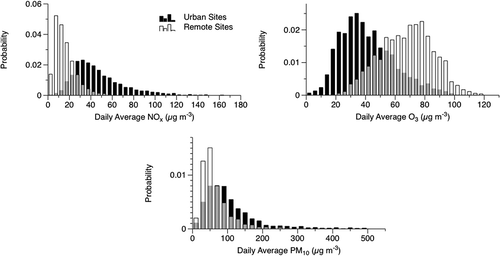
Seasonal cycle
Breaking down pollutant concentrations by month reveals clear annual cycles for some species and locations (, , nd 7). Globally, areas with NOx emissions dominated by anthropogenic sources tend to show winter peaks; even in locations where anthropogenic NOx emissions are generally constant throughout the year, impacts on lifetime brought about by changes in hydroxyl radical (OH•) can produce this winter peak (van der A et al., Citation2008). Seasonal shifts in the planetary boundary layer height may also play a role in NOx seasonality, independent of emissions. On the other hand, soil-dominated NOx regimes (including much of Saudi Arabia’s rural areas) tend to demonstrate summer peaks in NOx due to temperature-driven enhancement of soil emissions. In this study, the three sites within Jeddah seem to show NOx peaking in the winter, although the cycle may be confounded somewhat due to increased summer emissions from greater power generation to meet air-conditioning demand. The Jeddah background site, upwind of the urban plume, shows this winter peak most clearly out of all locations, with relatively constant emissions from transport in the Red Sea the most likely anthropogenic source (Richter et al., Citation2004). The North Kingdom site is similarly low, but shows both a summer and a winter peak, suggesting that both soil and anthropogenic emissions contribute to its modest NOx concentrations. The annual O3 cycle generally seems to peak during the summer months at all five sites, although it is far less distinct at the three urban locations. The relatively weak cycles for NOx and O3 at all stations can also be partially attributed to reduced seasonal changes in photolysis compared with the mid-latitudes.
Figure 5. Monthly NOx distributions for all five sites. Horizontal lines on each box indicate quartile values (25th, 50th, and 75th percentiles). Whiskers show 5th and 95th percentiles.
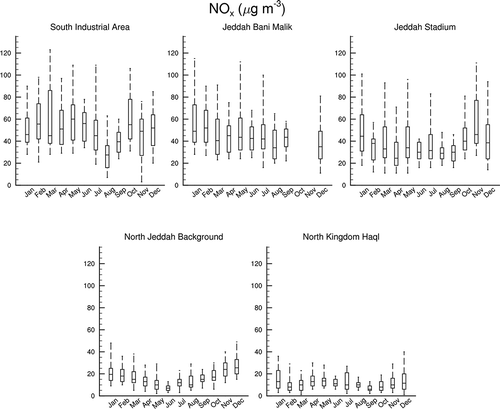
Figure 6. Monthly O3 distributions for all five sites. Horizontal lines on each box indicate quartile values (25th, 50th, and 75th percentiles). Whiskers show 5th and 95th percentiles.
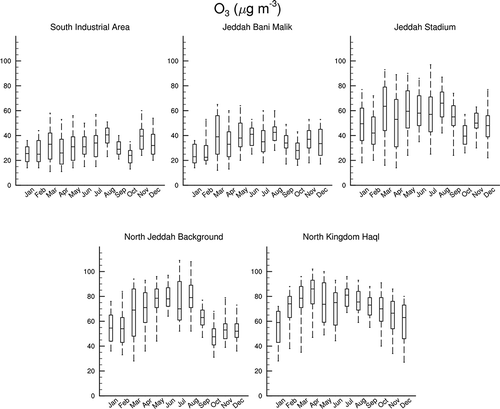
Figure 7. Monthly PM10 distributions for all sites. Horizontal lines on each box indicate quartile values (25th, 50th, and 75th percentiles). Whiskers show 5th and 95th percentiles.
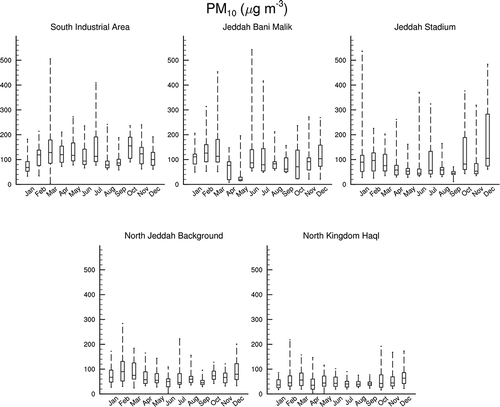
Table 1. Percent change in weekend versus weekday concentrations (all significant at 95% level)
Weekend effect
The Saudi weekend occurs on Thursday and Friday, with urban concentrations of NOx significantly reduced on those days (). Jeddah sites showed reductions in NOx ranging from −19% to −25% on Thursdays and Friday, whereas O3 concentrations rose by 12% to 15%. The two more remote sites did not exhibit this behavior, with small increases in NOx and almost negligible decreases in O3. Urban PM10 was greatly reduced on the weekends, showing reductions of 10–25%, whereas the North Jeddah Background and North Kingdom Haql sites showed weekend PM10 reductions of 8% and 2%, respectively. Although the lower overall O3 at the urban sites suggests reduced risk of O3-related health impacts in these and similar regions, the magnitude of weekend changes to air quality at the urban sites indicates that the sensitivity of O3 in urban regions to shifts in anthropogenic emissions is quite large—care should be taken in implementation of future policy changes to avoid increases in urban O3 concentrations. Overall reductions in urban NOx emissions may result in the higher weekend O3 levels occurring during the rest of the week as well, unless they are accompanied by additional controls of other emissions such as volatile organic carbons (VOCs).
Elevated concentrations of urban O3 on the weekends despite a reduction in the emission of its precursors is a well-documented phenomenon (Cleveland et al., Citation1974; Pun et al., Citation2003; Blanchard and Tanenbaum, Citation2003; Blanchard et al., Citation2008; Pusede and Cohen, Citation2012). This so-called “weekend effect” has several possible causes, including a reduction in the weekend titration of O3 by NO (via NO + O3 → NO2 + O2). Despite being an O3 precursor, fresh NOx emissions (which are predominantly NO) also suppress the buildup of O3 in their immediate area through this reaction, resulting in reduced O3 levels in the immediate vicinity of the NO source, but elevated O3 levels in areas further downwind. On the weekends, lower daytime NO emission rates allow O3 to build up earlier and at higher levels than on weekdays, leading to the observed effect. Another possible factor could be found in ambient NOx/VOC ratios, which can influence sensitivity of O3 formation to changes in its precursors (Sillman et al., Citation1990). Although both NOx and VOCs contribute to the reactions that serve as the primary source of tropospheric O3, an overabundance of one with respect to the other can lead to situations in which further increases begin to reduce O3 through direct titration. If VOC emissions in Jeddah are indeed drastically lower than NOx emissions, this could be the case. Further work examining NOx and VOC emissions will be necessary to fully explain the observed patterns of O3 formation. We hypothesize that reduced levels of biogenic emissions in most Saudi Arabian cities leads to VOC/NOx ratios much lower than those found in cities near more highly vegetated areas, leading to the effects observed in this study. An observation campaign focused on hourly measurements of NOx and VOCs in and around Jeddah would help to evaluate this hypothesis.
Meteorology
Jeddah air quality showed some dependence on local meteorology, with the highest levels of local O3 occurring, surprisingly, on days with the strongest winds. Wind direction for three of the four sites in and around Jeddah was predominantly from the northwest, with peak daily averages of around 3–5 m/sec. The two northern sites (NJB and JST) reported exceptionally high O3 concentrations on days with strong northwestern winds, whereas calm winds were associated with the lowest O3 concentrations. NOx levels at these two stations showed the opposite correlation, peaking on days with little to no wind and dropping to their lowest levels on the windiest days. Although wind speed and direction was similar at the Jeddah Bani Malik station further south, O3 levels remained much lower (and NOx levels much higher) than observed at the northern stations. The South Industrial Area station reported exceptionally low wind speeds, with typical days showing winds arriving from the east at less than 1 m/sec. O3 and NOx concentrations were similar to the nearby Bani Malik site, characterized by low O3 and high NOx concentrations. The North Kingdom Haql site had stronger average winds than the Jeddah sites, with much of it arriving from the northeast. NOx levels were lower than any of the Jeddah sites, whereas O3 levels were consistently high.
Positive correlations were found between O3 and wind speed at all sites except for the South Industrial Area station, where placement issues may have interfered with wind measurements. Linear regression of O3 versus wind speed produced slopes of 5.0, 14, 8.5, and 1.2 at the Jeddah Bani Malik, Jeddah Stadium, North Jeddah Background, and North Kingdom Haql sites, with r2 values of 0.22, 0.28, 0.19, and 0.05 (all significant for P < 0.05). These correlations could be explained by strong NOx titration of O3 within the city: on days with low average wind speeds, steady NO emissions, low VOC concentrations, and reduced mixing inhibit the local formation of O3, while allowing NOx to build up. Meanwhile, days with stronger average winds bring in O3-heavy air from just outside the city, where photo-oxidation and an absence of fresh NO emissions allows higher concentrations of the pollutant to form. This effect is visible in and , where urban locations show consistently high NOx and low O3 on days with little wind, and reversed trends on high-wind days. The more remote areas, including both the North Jeddah Background station upwind of the city and the North Kingdom Haql station show the highest O3 and lowest NOx, with transport from high-emitting urban and industrial areas likely responsible for the elevated levels observed there.
Figure 8. NOx concentrations for three stations by wind speed and direction, with north represented as the positive y-axis. The central Jeddah Stadium site shows much higher NOx concentrations, with winds from the northwest leading to reduced NOx. The North Jeddah Background site also shows higher days, but only when winds are minimal or southerly, allowing urban emissions to arrive. The North Kingdom Haql site has almost uniformly low NOx concentrations, although strong winds from the southeast are associated with higher levels.
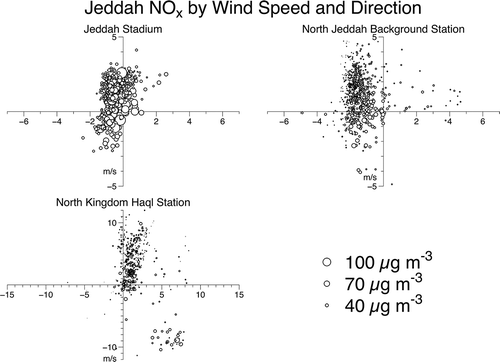
Figure 9. O3 concentrations for three stations by wind speed and direction, with north represented as the positive y-axis. The Jeddah Stadium site displays lower O3 overall, with higher levels apparent on windier days, whereas the two remote sites show uniformly higher levels, even on calm days.
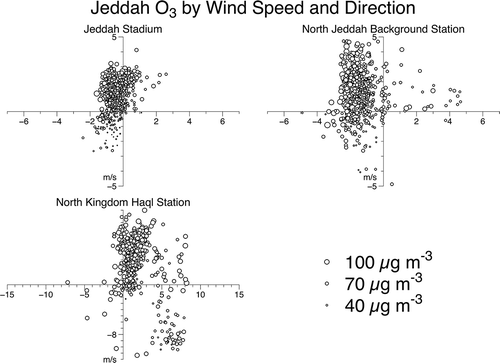
Increases in temperature are generally known to be associated with higher daily O3 levels due to the temperature and radiation-flux dependence of O3 formation. Although this effect was evidenced through linear regression at both the North Kingdom Haql and North Jeddah Background sites (positive slopes of 0.24 and 1.9, respectively), the Jeddah sites showed insignificant or even negative relationships between temperature and daily O3 levels (slopes of −0.37 and −0.64 at the South Industrial Area and Jeddah Stadium sites, both significant at P < 0.05). This temperature relationship may further indicate an extremely strong NOx titration effect, suppressing O3 formation and leaving wind as the dominant meteorological driver of O3 variability within the urban plume of Jeddah.
O3/PM10 interactions
In addition to the direct health impacts of PM10 upon human health, it can serve as a confounding factor on O3 levels. High concentrations of PM10 can block incoming radiation, slowing the photochemical reactions that drive O3 formation, and can also effectively increase the number of uptake sites for heterogeneous chemical reactions between O3 and other species (Astitha and Kallos, Citation2008). For both of these reasons, high levels of dust have been found to anticorrelate with O3 levels. As with the O3-temperature correlation, however, this effect was found to be largely suppressed within the Jeddah urban area. O3 levels at all sites were compared with wind speeds, normalized wind direction components, temperature, and PM10 concentrations through multiple linear regression, and the resulting coefficients for PM10 were examined for all sites. Whereas both the Haql and North Jeddah Background sites showed small, but significant anticorrelations with PM10, sensitivities were much smaller in all urban sites, with none of those correlations proving significant at P < 0.05. The negative impact of PM10 upon O3 was apparent at all sites, but does not seem to be the primary driver for the reduced O3 levels observed at the urban locations.
Conclusions
Overall, the city of Jeddah shows remarkably low O3 levels for a city of its size, suggesting the need for further examination of the emissions and chemistry in the region. The reduced O3 levels in the presence of high NOx levels support the conclusion that NOx titration may be an important contributor to Jeddah chemistry. At all urban sites, weekend NOx reductions were accompanied by a strong O3 increase of over 15%, further, suggesting either extreme VOC sensitivity or a strong O3 quenching effect from steady NO emissions. Sites further away from the city center showed reduced NOx concentrations and greatly increased O3 levels, along with reduced sensitivity to weekday versus weekend changes, implying primarily transport-driven variability. To assess NOx sensitivity, more comprehensive measurements will be needed, including measurements of NOy (NOx + oxidation products) and VOCs.
Elevated O3 concentrations during the summer months, especially in areas somewhat removed from primary NOx sources, indicate increased health risks for annual pilgrims attending Hajj, as the dates for the pilgrimage move through the summer over the coming years. Although central urban locations show suppressed O3 levels due to quenching or extremely low NOx sensitivity, small changes in local NOx emissions may result in sudden swings in air quality (as evidence by the observed weekend effect). Furthermore, areas just outside of the urban plume of high-emitting regions are likely to bear the brunt of high NOx emissions, as they will experience heightened O3 and PM levels without the O3 reductions observed within the city itself. Increased attention to emissions and transport now may prove instrumental to reducing O3-related mortality and morbidity increases over the next two decades.
Although urban O3 levels were generally lower than those of comparable cities, PM10 appears to be of some concern within the city of Jeddah: daily average concentrations were well above those of comparable U.S. cities, as well as international standards. More work will be necessary to properly assess the composition, source apportionment, and size distributions so as to develop an effective strategy for managing particulate matter concentrations and their negative impact on human health. Areas outside of the city showed lower levels of particulate matter, suggesting that urban activities or emissions from within the city of Jeddah itself may be responsible for a large percentage of the elevated concentrations. Studies specifically targeting the especially dangerous PM2.5 concentrations and sources will be necessary to further evaluate the impacts of urban particulate matter emission and formation on human health. Previous investigation has shown PM2.5/PM10 ratios in Jeddah of approximately 0.33 (Khodeir et al., Citation2012), possibly indicating frequent days with elevated health risks based on expected PM2.5 concentrations.
These results also suggest that care should be taken in future emission controls in the Jeddah region, and other high-emission areas. Although lower NOx emissions overall would likely reduce downwind O3, it could also result in significantly higher O3 within the city itself if not accompanied by other measures also addressing VOC emissions. Regional NOx/VOC sensitivities should be carefully assessed and used to determine the most effective means of O3 reduction in and around the city—it may be that reducing regional VOC emissions would prove to have the most positive impact on O3 in both urban and rural locations. To this end, comprehensive emission inventories will be necessary to provide the modeling infrastructure that could evaluate future emission scenarios.
Acknowledgment
The authors acknowledge technical and financial support of King Abdulaziz University. The Presidency of Meteorology and Environment (PME) in Saudi Arabia is also acknowledged for providing observational data sets. Additional support was provided by Andarz Co. in Portland, Oregon. The authors also thank the Institute of Sustainable Solutions at Portland State University for computational resources.
Funding
This paper was funded by King Abdulaziz University, under grant no. (4-10-1432/HiCi).
Additional information
Notes on contributors
William C. Porter
William C. Porter is a postdoctoral associate in the Department of Civil and Environmental Engineering at the Massachusetts Institute of Technology.
M. Aslam K. Khalil
M. Aslam K. Khalil is a professor of physics and Christopher L. Butenhoff is an associate professor of physics at Portland State University.
Mansour Almazroui
Mansour Almazroui is director of the Center of Excellence for Climate Change Research, as well as head of the Department of Meteorology and Abdulrahman K. Al-Khalaf is a professor of Meteorology at King Abdulaziz University in Jeddah, Saudi Arabia.
Mohammed Saleh Al-Sahafi
Mohammed Saleh Al-Sahafi is Director General of Environmental Standards & National Ozone Coordinator at the Presidency of Meteorology and Environment in Jeddah, Saudi Arabia.
References
- Al Frayh, A.R., Z. Shakoor, M.O. ElRab, and S.M. Hasnain. 2001. Increased prevalence of asthma in Saudi Arabia. Ann. Allergy. Asthma. Immunol. 86:292–296. doi:10.1016/S1081-1206(10)63301-7
- Al Katheeri, E. 2012. Assessment of gaseous and particulate pollutants in the ambient air in Al Mirfa City, United Arab Emirates. J. Environ. Prot. 3: 640–647. doi:10.4236/jep.2012.37077
- Anenberg, S.C., J.J. West, A.M. Fiore, D.A. Jaffe, M.J. Prather, D. Bergmann, K. Cuvelier, F.J. Dentener, B.N. Duncan, and M. Gauss. 2009. Intercontinental impacts of ozone pollution on human mortality. Environ. Sci. Technol. 43: 6482–6487. doi:10.1021/es900518z
- Astitha, M., and G. Kallos. 2008. Gas-phase and aerosol chemistry interactions in South Europe and the Mediterranean region. Environ. Fluid Mech. 9:3–22. doi:10.1007/s10652-008-9110-7
- Bell, M. 2004. Sensitivity analysis of tropospheric ozone to modified biogenic emissions for the Mid-Atlantic region. Atmos. Environ. 38:1879–1889. doi:10.1016/j.atmosenv.2004.01.012
- Blanchard, C.L., and S. Tanenbaum. 2003. Differences between Weekday and Weekend Air Pollutant Levels in Southern California. J. Air Waste Manag. Assoc. 53:816–828. doi:10.1080/10473289.2003.10466222
- Blanchard, C.L., S. Tanenbaum, and D.R. Lawson. 2008. Differences between weekday and weekend air pollutant levels in Atlanta; Baltimore; Chicago; Dallas–Fort Worth; Denver; Houston; New York; Phoenix; Washington, DC; and surrounding areas. J. Air Waste Manage. Assoc. 58:1598–1615. doi:10.3155/1047-3289.58.12.1598
- Boersma, K.F., H.J. Eskes, and E.J. Brinksma. 2004. Error analysis for tropospheric NO2 retrieval from space. J. Geophys. Res. Atmos. 109: D04311. doi:10.1029/2003JD003962
- Boersma, K.F., H.J. Eskes, J.P. Veefkind, E.J. Brinksma, R.J. van der A, M. Sneep, G.H.J. van den Oord, P.F. Levelt, P. Stammes, J.F. Gleason et al. 2007. Near-real time retrieval of tropospheric NO2 from OMI. Atmos. Chem. Phys. 7: 2103–2118. doi:10.5194/acp-7-2103-2007
- Cleveland, W.S., T.E. Graedel, B. Kleiner, and J.L. Warner. 1974. Sunday and workday variations in photochemical air pollutants in New Jersey and New York. Science 186:1037–1038. doi:10.2307/1739230
- Dockery, D.W., and C.A. Pope. 1994. Acute respiratory effects of particulate air pollution. Annu. Rev. Public Health 15:107–132. doi:10.1146/annurev.pu.15.050194.000543
- Khodeir, M., M. Shamy, M. Alghamdi, M. Zhong, H. Sun, M. Costa, L.-C. Chen, and P. Maciejczyk. 2012. Source apportionment and elemental composition of PM2.5 and PM10 in Jeddah City, Saudi Arabia. Atmos. Pollut. Res. 3: 331–340. doi:10.5094/APR.2012.037
- Khoder, M.I. 2009. Diurnal, Seasonal and weekdays–weekends variations of ground level ozone concentrations in an urban area in greater Cairo. Environ. Monit. Assess. 149:349–362. doi:10.1007/s10661-008-0208-7
- Krzyzanowski, M., and A. Cohen. 2008. Update of WHO Air Quality Guidelines. Air Qual. Atmos. Health 1:7–13. doi:10.1007/s11869-008-0008-9
- Lelieveld, J., P. Hoor, P. Jöckel, A. Pozzer, P. Hadjinicolaou, J.-P. Cammas, and S. Beirle. 2009. Severe ozone air pollution in the Persian Gulf region. Atmos. Chem. Phys. 9:1393–1406. doi:10.5194/acp-9-1393-2009
- Lippmann, M. 1989. Health effects of ozone: A critical review. JAPCA 39: 672–695. doi:10.1080/08940630.1989.10466554
- Munir, S., T.M. Habeebullah, A.R. Seroji, S.S. Gabr, A.M.F. Mohammed, and E.A. Morsy. 2013. Quantifying temporal trends of atmospheric pollutants in Makkah (1997–2012). Atmos. Environ. 77:647–655. doi:10.1016/j.atmosenv.2013.05.075
- Nasralla, M.M. 1983. Air pollution in the semitropical Saudi Urban area. Environ. Int. 9:255–264. doi:10.1016/0160-4120(83)90083-1
- Pun, B.K., C. Seigneur, and W. White. 2003. Day-of-week behavior of atmospheric ozone in three U. Scities. J. Air Waste Manage. Assoc. 53:789–801. doi:10.1080/10473289.2003.10466231
- Pusede, S.E., and R.C. Cohen. 2012. On the observed response of ozone to NOx and VOC reactivity reductions in San Joaquin Valley California 1995–present. Atmos. Chem. Phys. 12:8323–8339. doi:10.5194/acp-12-8323-2012
- Richter, A., V. Eyring, J.P. Burrows, H. Bovensmann, A. Lauer, B. Sierk, and P.J. Crutzen. 2004. Satellite measurements of NO2 from international shipping emissions. Geophys. Res. Lett. 31:L23110. doi:10.1029/2004GL020822
- Rowe, D.R., M.A. Nouh, K.H. Al-Dhowalia, and M.E. Mansour. 1985. Indoor-outdoor relationship of suspended particulate matter in Riyadh, Saudi Arabia. J. Air Pollut. Control Assoc. 35:24–26. doi:10.1080/00022470.1985.10465880
- Samoli, E., A. Analitis, G. Touloumi, J. Schwartz, H.R. Anderson, J. Sunyer, L. Bisanti, D. Zmirou, J.M. Vonk, J. Pekkanen et al. 2005. Estimating the exposure–response relationships between particulate matter and mortality within the APHEA Multicity Project. Environ. Health Perspect. 113:88–95. doi:10.1289/ehp.7387
- Sillman, S., J. Logan, and S. Wofsy. 1990. The sensitivity of ozone to nitrogen oxides and hydrocarbons in regional ozone episodes. J. Geophys. Res. 95: 1851–1851.
- Tangborn, A., I. Stajner, M. Buchwitz, I. Khlystova, S. Pawson, J. Burrows, R. Hudman, and P. Nedelec. 2009. Assimilation of SCIAMACHY total column CO observations: Global and regional analysis of data impact. J. Geophys. Res. 114:D07307. doi:10.1029/2008JD010781
- U.S. Environmental Protection Agency. 2013. Air Quality System Data Mart. http://www.epa.gov/ttn/airs/aqsdatamart ( accessed May 29, 2013).
- van der A, R.J., H.J. Eskes, K.F. Boersma, T.P.C. van Noije, M. Van Roozendael, I. De Smedt, D.H.M.U. Peters, and E.W. Meijer. 2008. Trends, seasonal variability and dominant NOx source derived from a ten year record of NO2 measured from space. J. Geophys. Res. Atmos. 113: D04302. doi:10.1029/2007JD009021
- Zakey, A.S., M.M. Abdel-Wahab, J.B.C. Pettersson, M.J. Gatari, and M. Hallquist. 2008. Seasonal and spatial variation of atmospheric particulate matter in a developing megacity, the greater Cairo, Egypt. Atmósfera 21: 171–189.
